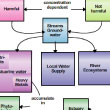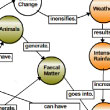Ocean Literacy Principle 1G: The ocean is connected to major lakes, watersheds and waterways because all major watersheds on Earth drain to the ocean. Rivers and streams transport nutrients, salts, sediments and pollutants from watersheds to estuaries and to the ocean.
| |
|
|
|
| Scientist map | | Consensus map |
How Does Landscape Affect the Ecology of Coastal Waters? Linda Kalnejais (scientist) and educators Marjorie Inderbitzen, Linda McIntosh, and Gary Neilsen
Save map to CMB: Scientist Map | Consensus Map
Download (pdf): Scientist Map | Consensus Map
Since Dr. Kalnejais studies what happens to pollutants in the coastal ocean, her map focused on how the landscape impacts coastal waters. In her initial map, she addressed how climate affects rainfall and groundwater and, by interacting with the landscape, can carry particulates into the estuary and, eventually, coastal waters. These particulates can have good and bad effects. After working with the educators, they reconstructed the map to delineate human impact from the natural landscape. They also separated harmful from non harmful impacts, and showed how streams and groundwater not only contribute to estuaries and rivers, but also to the local water supply which directly impacts people.
| |
|
|
|
| Scientist map | | Consensus map |
Ru Morrison (scientist) and educators John Diamond and Aimee Hayden-Roderiques
Save map to CMB: Scientist Map | Consensus Map
Download (pdf): Scientist Map | Consensus Map
Dr. Morrison’s original concept map was rather complex but the central point of entry was runoff. Effects of runoff are seen on the bottom half of his map, particularly what is contained in runoff water. His team decided to focus on climate change impacts that are important to New England shellfisheries. Their consensus map shows that climate change can lead to short, intense storms that result in runoff containing high levels of fecal bacteria and excessive nutrients. The nutrients can lead to Harmful Algal Blooms that contain toxins that can be concentrated in shellfish. Aimee Hayden-Roderiques works at the Maine Department for Marine Resources, and will use their consensus map with people ages 10 and older. John Diamond volunteers at the Seacoast Science Center, and will use the map as a standalone resource to complement existing exhibit content.
|









